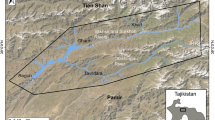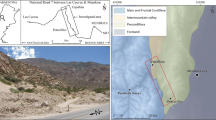Abstract
Landslide activity responds to rapid environmental changes and represents a relevant geoindicator in mountainous or hilly areas. This paper discusses the socio-economic relevance of landslide hazard in Italy and the problems encountered in establishing relationships between landslide frequency, climate and vegetation changes at different time scales. Landslides blocking a river channel have been carefully taken into account because they are usually characterized by high intensities (with regard to the involved masses and movement velocities) and their occurrences are often datable via radiocarbon dating. This is due to the recovery of organic matter in the landslide dammed lakes. For these reasons they can be considered important geoindicators in the wider category of slope failures. The marked effects of the anthropogenic activity on slope instability processes in the last 50 years are discussed with reference to two case histories: the Chianti hills in Tuscany and the Cinque Terre National Park in Liguria. Finally, two novel techniques of remote sensing are proposed as tools for a systematic monitoring of slope instability at different time and spatial scales. Both techniques are based on the interferometric synthetic aperture radar (SAR) technology and differ on the type of platform (satellite and ground-based) used to acquire data.










Similar content being viewed by others
References
Allievi J, Ambrosi C, Ceriani M, Colesanti C, Crosta GB, Ferretti A, Fossati D, Menegaz A (2003) Integration of field and remote sensing techniques for landslides monitoring. EGS 27th General Assembly, Nice, France, April 2002 (in prep)
Almagià R (1907) Studi Geografici sopra le frane in Italia. Mem Soc Geogr It 13(1):342
Atzeni C, Canuti P, Casagli N, Leva D, Luzi G, Moretti S, Pieraccini M, Sieber AJ, Tarchi D (2002) Ground-based radar interferometry: a novel technique for monitoring unstable slopes and cliffs. In: McInnes RG, Jakeways J (eds) Instability planning and management: Seeking sustainable solutions to ground movement problems. Thomas Telford, London, pp 447–454
Berger AR, Iams WJ (1996) Geoindicators: assessing rapid environmental changes in Earth systems. Balkema, Rotterdam, 466 pp
Bertolini G, Casagli N, Ermini L, Malaguti C (2003) Radiocarbon dating of landslides in the Northern Apennine. Natural Hazard and Earth System Sciences (in press)
Calindri S (1781) Dizionario corografico, georgico, orittologico, storico della Italia, six volumes. Bologna
Campbell RH (1973) Isopleth map of landslide deposits, Poit Dume quadrangle, Los Angeles County, California. US Geol Surv Misc Field Studies Map MF-535 (scale 1:24,000)
Canuti P, Garzonio CA, Rodolfi G (1979) Dinamica morfologica di un ambiente soggetto a fenomeni franosi e ad intensa attività agricola. Area rappresentativa di Montespertoli, Firenze. Annali Istituto Sperimentale Studio e Difesa del Suolo, Firenze, vol 10, pp 81–102
Canuti P, Focardi P, Garzonio CA, Rodolfi G, Vannocci P (1986) Slope stability mapping in Tuscany, Italy. In: Gardiner V (ed) International Geomorphology. Wiley, New York, pp 231–240
Canuti P, Cascini L, Dramis F, Pellegrino A, Picarelli L (1988) Landslides in Italy: occurrence, analysis and control. Workshop on Natural Disasters in European Mediterranean Countries, Colombella, Perugia, pp 165–184
Canuti P, Casagli N, Ermini L (1998) Inventory of landslide dams in the Northern Apennine as a model for induced flood hazard forecasting. In: K. Andah (ed) Managing hydro-geological disasters in a vulnerate environment. CNR-GNDCI-UNESCO (IHP), pp 189–202
Canuti P, Casagli N, Pellegrini M, Tosatti G (2001) Geo-hydrological hazard. In: Vai GB, Martini IP (eds) Anatomy of an orogen: the Apennines and adjacent Mediterranean basins. Kluwer, Dordrecht, pp 513–532
Canuti P, Casagli N, Leva D, Moretti S, Sieber A, Tarchi D (2002) Landslide monitoring by using ground-based radar interferometry. In: Rybar J, Stemberk J, Wagner P (eds) Landslides. Proceedings 1st European Conference on Landslides, Prague, 24–26 June 2002. Balkema, Rotterdam, pp 523–528
Casagli N, Ermini L (1999) Geomorphic analysis of landslide dams in the Northern Apennine. Japanese Geomorphological Union Transactions 20(3):219–249
Casagli N, Farina P, Leva D, Nico G, Tarchi D (2002) Monitoring the Tessina landslide by a ground-based interferometer and assessment of the system accuracy. Proceedings IGARSS 2002 - International Geoscience and Remote Sensing Symposium, Toronto, Canada, 21–26 April, 2002
COGEOENVIRONMENT (IUGS) Working Group on geoindicators (1995) Geoindicator checklist: explanation of format (http://www.gcrio.org/geo/chklt.html)
Corsini A, Pasuto A, Soldati M (1999) Geomorphological investigation and management of the Corvara landslide (Dolomites, Italy). Japanese Geomorphological Union Transactions 20(3):169–186
Corsini A, Pasuto A, Soldati M (2000) Landslides and climate change in the Alps since the late glacial: evidence of case studies in the Dolomites (Italy). In: Bromhead E, Dixon N, Ibsen M (eds) Landslides in research, theory and practice. Proc 8th Symp Landslides. Thomas Telford, London, pp 229–234
Costa JE, Schuster RL (1991) Documented historical landslide dams from around the world, USGS Open File Report 91–239, 486 pp
De Graff J, Canuti P (1988) Using isopleth mapping to evaluate landslide activity in relation to agricultural practices. Bulletin of the Association of Engineering Geology 38:61–71
Dikau R, Schrott L (1999) The temporal stability and activity of landslides in Europe with respect to climatic change (TESLEC): main objectives and results. Geomorphology 30:1–12
Ermini L, Casagli N (2003) Prediction of the behaviour of landslide dams using a geomorphological dimensionless index. Earth Surf Processes 28(1):31–47
Ferretti A, Prati C, Rocca F (2000) Non-linear subsidence rate estimation using permanent scatterers in differential SAR interferometry. IEEE Trans Geosci Remote Sensing 38(5):2202–2212
Ferretti A, Prati C, Rocca F (2001) Permanent scatterers in SAR interferometry. IEEE Trans Geosci Remote Sensing 39(1):8–20
Fruneau B, Achache J, Delancourt C (1996) Observation and modeling of the Saint- Etienne-de-Tinee landslide using SAR interferometry. Tectophysics 265:181–190
Gabriel AK, Goldstein RM, Zebker HA (1989) Mapping small elevation changes over large areas: Differential radar interferometry. J Geophys Res 94, 9183–9191
Guzzetti F (2000) Landslide fatalities and the evaluation of landslide risk in Italy. Eng Geol 58:89–107
Guzzetti F, Cardinali M, Reichenbach P (1994) The AVI Project: a bibliographical and archive inventory of landslides and floods in Italy. Environ Management 18(4):623–633
IUGS/WGL—International Union of Geological Sciences Working Group on Landslides (1995) A suggested method for describing the rate of movement of a landslide. IAEG Bull 52:75–78
Kimura H, Yamaguchi Y (2000) Detection of landslide areas using radar interferometry. Phot Eng Remote Sensing 66(3):337–344
Marabini F, Veggiani A (1993) Evolutional trends of the coastal zone and the influence of climatic fluctuations. In: Grifman PM, Fawcett JA (eds) International perspectives on coastal ocean space utilization. Proc 2nd Int Symp Coastal Ocean Space Utilization (COSU II), April 2–4, Long Beach, California
Massonnet D, Feigl KL (1998) Radar interferometry and its applications to changes in the Earth’s surface. Rev Geophys 36(4):441–500
Massonnet D, Rossi M, Carmona C, Adragna F, Peltzer G, Feigl K, Rabaute T (1993) The displacement field of the Landers earthquake mapped by radar interferometry. Nature 364:138–142
Massonnet D, Briole P, Arnaud A (1995) Deflation of Mount Etna monitored by space radar interferometry. Nature 375:567–570
Naiman R, Beechie TJ, Benda LE, Berg DR, Bi’ PA, MacDonald LH, O’Connor MD, Olson PL, Zeel EA (1992) Fundamental elements of ecologically healthy watersheds in the Pacific Northwest coastal ecoregion. In: Naiman RJ (ed) Watershed management: -balancing sustainability with environmental change. Springer, Berlin Heidelberg New York, pp 127–188
Orombelli G, Ravazzi C (1996) The Late Glacial and Early Holocene: Chronology and paleoclimate. Il Quaternario 9(2)
Refice A, Guerriero L, Bovenga F, Wasowski J, Atzori S, Ferrari AR, Marsella M (2001) Detecting landslide activity by SAR interferometry. Proc ERS-ENVISAT Symposium, Goteborg
Regione Emilia-Romagna (1999) I numeri sulle frane. Servizio Cartografico, Pendragon ed, Bologna
Rizzo V, Tesauro M (2000) SAR interferometry and field data of Randazzo landslide (Eastern Sicily, Italy). Phys Chem Earth (B) 25(9):771–780
Rott H, Siegel A (1999) Analysis of mass movements in alpine terrain by means of SAR interferometry. Proc IGARSS’99, Hamburg, pp 1993–1939
Rott H, Mayer C, Siegel A (2000) On the operational potential of SAR interferometry for monitoring mass movements in alpine areas. Proc of EUSAR 2000, Munchen, Germany, pp 43–46
Rudolf H, Leva D, Tarchi D, Sieber AJ (1999) A mobile and versatile SAR system. Proc IGARSS’99, Hamburg, pp 592–594
Schuster RL (1996) Socio economic significance of landslides. In: Turner KA, Schuster RL (ed) Landslides, investigation and mitigation. Special Report 247, Transportation Research Board, National Research Council, pp 12–35
Strozzi T, Wegmuller U, Tosi L, Bitelli G, Spreckels V (2001) Land subsidence monitoring by differential SAR interferometry. Photogrammetric Engineering and Remote Sensing 67:1261–1270
Tarchi D, Ohlmer E, Sieber AJ (1997) Monitoring of structural changes by radar interferometry. Res Nondestruct Eval 9:213–225
Tarchi D, Casagli N, Fanti R, Leva D, Luzi G, Pasuto A, Pieraccini M, Silvano S (2003a). Landslide monitoring by using ground-based SAR interferometry: an example of application to the Tessina landslide in Italy. Eng Geol 68(1–2):15–30
Tarchi D, Casagli N, Leva D, Luzi G, Moretti S, Pieraccini M, Sieber AJ (2003b) Monitoring landslide displacements by using ground-based differential SAR interferometry: application to the Ruinon landslide in the Italian Alps. J Geophys Res (in press)
Zebker HA, Goldstein RM (1986) Topographic mapping from interferometric Synthetic Aperture Radar observations. J Geophys Res 91:4993–4999
Acknowledgments
The authors want to thank Jan Vlcko for the careful revision of the paper. They are also grateful to Dr. Dario Tarchi, who together with all the radar group at the European Joint Research Centre of Ispra, is acknowledged for providing material and suggestions on the remote sensing monitoring of landslides. Authors are also grateful to Peter T. Bobrowsky for the invitation to the IUGS/CoGeoenvironment GRUDEC—International Workshop and Seminar on Geoindicators in Mountainous Areas in Cusco and Urubamba (Perù) 29 September–5 October 2002, where this paper was orally presented. Authors want to thank Stefano Amato, Antonietta del Piccolo and Massimiliano Nocentini for providing data and information regarding the Chianti hills and Cinque Terre sites. This research has been funded from the CNR-GNDCI U.O. 2.14 (Coordinator Prof. Nicola Casagli), CNR—Contract n. 01.01018.PF42
Author information
Authors and Affiliations
Corresponding author
Rights and permissions
About this article
Cite this article
Canuti, P., Casagli, N., Ermini, L. et al. Landslide activity as a geoindicator in Italy: significance and new perspectives from remote sensing. Env Geol 45, 907–919 (2004). https://doi.org/10.1007/s00254-003-0952-5
Received:
Accepted:
Published:
Issue Date:
DOI: https://doi.org/10.1007/s00254-003-0952-5




